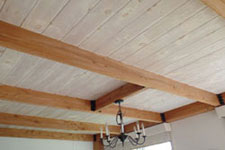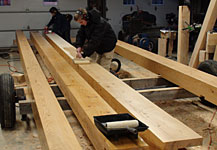BungalowInABox
Thinking Ahead
Planning: March 15, 2019
My first real experience with staining was when we decided after raising our timber frame for our home, the installed tongue and groove boards on our first floor ceiling needed to be white-washed to make the space brighter. Over twenty years later, I am looking up and seeing the results of my endeavor and reminded of the benefit of thinking ahead. The white-washing entailed standing on a ladder for several days and using a small sponge on a stick to work the stain into the tongue and grooves between the boards. It also involved affixing a lot of tape to the timbers to avoid getting the white stain onto the golden hemlock.
I felt a great sense of accomplishment in the work I did, but the quality of my effort is questionable. It was difficult to evenly saturate every tongue and groove and to avoid getting stain on to the timbers. We had to do a good amount of sanding afterward to remove the small white marks on the post and beams. After completing the white-washing, we decided not to stain our timbers and instead move on to completing other parts of our house. The initial exposure to the weather and the subsequent exposure to sun over the years has changed the color of our timbers. We enjoy the richness of the current hue, but some might prefer a more consistent and reliable finish.
Today, we talk with our clients about the benefits of pre-staining before we raise the timber frame. I have spent many hours rolling stain on to our frames, using a brush to work the stain into the mortise and tenons, fully saturating the end grain and making sure there are no drips of extra stain. Today, we use a product that prevents discoloring from the the sun's UV rays and mildew. The best part is that it helps preserve the natural color of the wood. Some people prefer an opaque application so they have a consistent color. We can offer some recommendations.


